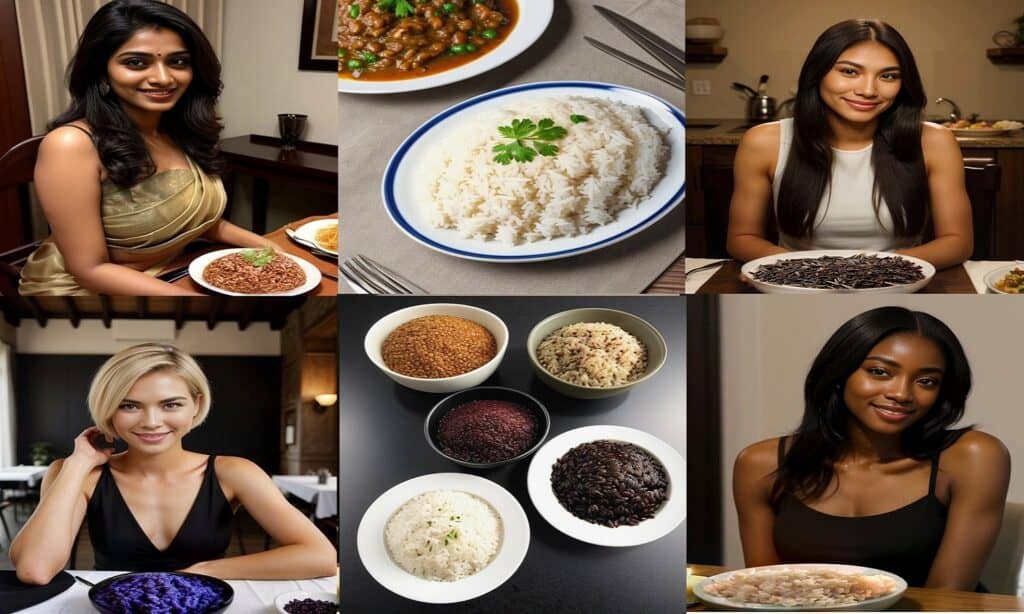Table of Contents
Colored Rice vs. White Rice

Rice is one of the most preferred cereal grains in the world. It is the most popular staple food in Asia, Africa, and Latin America. In Northern America and Europe, rice may not be a staple food but people in these regions do consume rice. The rice plant belongs to the grass family and the rice itself is a type of seed.
The Asian continent, due to its climate and soil structure suited the most for the cultivation of rice. Also, the populace in Asian countries prefers rice over any other cereals. In 2021-22, China, India, and Bangladesh were the top three rice-producing countries in the entire world. The top 10 rice-producing countries were all from the Asian continent. Asian countries are also among the top rice-exporting nations. India, Thailand, and Vietnam are the top three rice exporting countries in 2022-23.
Some estimate suggests that there could be as many as 100,000 varieties of rice. However, currently, two types of rice are cultivated widely – Oryza Sativa and Oryza Glaberrima. Oryza Sativa is the Asian variety which is the most cultivated one while Oryza Glaberrima is the African variety. Asian variety, Oryza Sativa, has a better yield compared to its African counterpart. Also, the aromatic varieties (such as Basmati, Jasmin, etc) of the Oryza Sativa are very popular across the world and they are sold as premium products.
Of all the rice varieties, white rice is the most popular and widely consumed. The actual rice grain, the seed of the rice plant, is called unmilled rice. This unmilled rice grain has to be processed and milled before it becomes white rice. The milling process removes the outer husk of the rice seed. Then it removes all the layers of bran and the germ. After this process, only the kernel of the rice seed remains which is white and the most pristine form of edible rice. The milling process changes the taste, texture, and appearance of the rice and increases its shelf life.
As the outer husk, all the layers of bran, and germ are removed, white rice is pure carb and full of calories. Due to the milling process, most of the dietary fiber, vitamins, and various minerals (iron, manganese, phosphorus) are lost. So, when we eat white rice, we get a lot of calories and close to zero nutrients and fibers. This, along with an unhealthy modern lifestyle, could lead to various non-communicable diseases such as obesity, type-2 diabetes, high blood pressure, cancer, etc. Instead of white rice, the colored rice varieties that do not go through the rigorous milling process are healthier options.
As these colored rice varieties do not go through a rigorous milling process, they have more dietary fiber than white rice. Due to this, consuming the same amount of colored rice will provide fewer calories compared to consuming white rice. Also, the dietary fibers present in these colored rice varieties will help us fight off various lifestyle diseases and aid in digestion. Due to the absence of a strict milling process, the colored rice versions preserve various essential nutrients such as vitamins B1, B3, B6, vitamin C, iron, zinc, phosphorus, manganese, etc.
So, consuming the colored rice varieties would help us solve many of our modern worries. As a good wellness habit, we could replace the white rice with colored rice options. In this article, we are going to talk about 4 colored rice varieties that are better and healthier than white rice.
1. Brown Rice
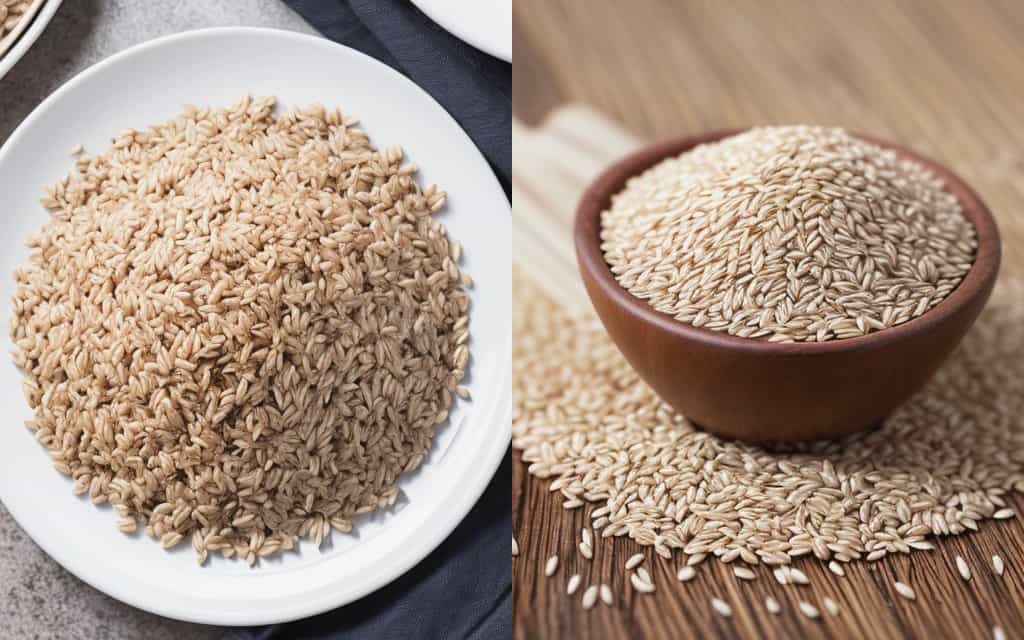
Brown rice is colored rice that has brown pigment. To make this colored rice variety, during the milling process, the inedible husk that envelops the rice grain seed is removed from the seed. However, unlike white rice, brown rice gets to keep its bran layers and germ. The outer bran layer which generally has brown pigment, gives this colored rice the brown hue. The outer bran layer of this colored rice gives it a hard construct compared to white rice. Due to the tough outer bran, brown rice takes more time to cook than white rice. The brown rice has a hard texture and it feels rough and chewy.
It is the tough outer bran layers and the germ that make this colored rice more nutritious and healthier than white rice. Compared to white rice, brown rice has less calories and more dietary fiber. The presence of more dietary fiber in brown rice means that we need to consume less amount of rice to fill our stomachs and in turn, it would lower our overall calorie intake. The dietary fiber will relieve us from various stomach and digestion-related alignments and may aid us in our efforts to maintain our weight.
Due to the high fiber content of this colored rice, it has a higher glycemic index – meaning brown rice will take time to turn to sugar in our bloodstream. This way brown rice helps us maintain blood sugar levels. Regular intake of brown rice instead of white rice may prevent type-2 diabetes, Brown rice also has a higher level of vitamin B1 or thiamine, B3 or niacin, and vitamin B6 or pyridoxine. These vitamins help the body to turn glucose into energy. These vitamins also aid in brain development and maturing of our nervous system. They also help protect our nervous system from any alignment or any disorder.
Brown rice contains antioxidants such as flavonoids and phenols. These antioxidants rid our bodies of free radicals and hence aid us in stopping cell damage. The antioxidants present in this colored rice may help us prevent cancer. They also aid us in strengthening our immunity. Brown rice also has essential minerals such as iron, zinc, magnesium, phosphorus, selenium, etc. Regular intake of brown rice may help lower the risks of developing heart disease. Brown rice may also lower the chances of having a heart attack. It may also aid in lowering the bad cholesterol in the bloodstream and promote the development of healthy red blood cells.
2. Wild Rice
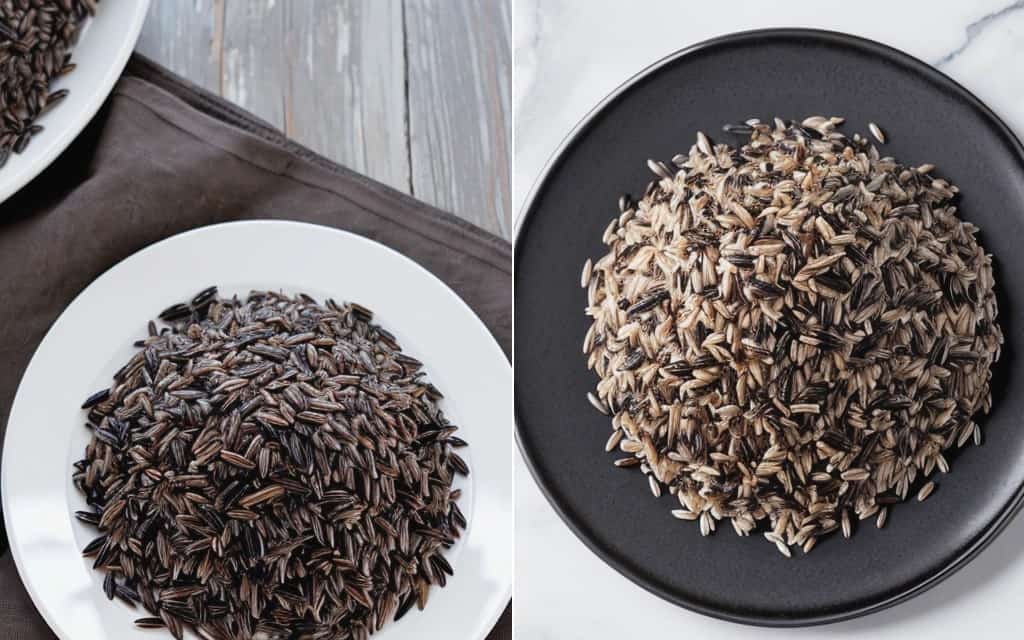
Wild rice is a type of colored rice that belongs to the grass family named – ‘Zizania’. The colored rice produced from this family of grass has a dark or black tinge to it. This family of grass does not belong to the Oryza Sativa or Oryza Glaberrima although it is closely related to them. So technically it is not a ‘rice’ at all instead seed of grass family ‘Zizania’.
There are four types of grass from which wild rice is cultivated. Out of these three types of grasses (Zizania texana, zizania palustris, and zizania aquatic) are native to North America and can be found near waterways, rivers, swamps, or lakes. The fourth variety, called Manchurian Wild Rice or Zizania latifolia, is native to China and is cultivated for its stem. The soft edible stem is cooked as a vegetable.
These gasses can sprout without any human effort although due to climate change and environmental damage, they are disappearing. The native tribes of North America have cultivated and consumed this colored rice for centuries. However, the wild rice that we cultivate and consume in modern times, is a domesticated version of its wild cousin. The grain can be very long and has a dark/black/purple color. Some versions of grain can be short with dark or black color.
This colored rice takes longer to cook than white rice or brown rice. The rice has a tough and rough texture and can be chewy and earthy in flavor. Since the grains of this colored rice are longer, upon boiling, the same amount of wild rice, compared to white rice, will produce a greater amount of cooked rice. Upon cooking, this colored rice will have a black and white hue to it. Just like white rice, cooked wild rice can be eaten with gravy, curry, or cooked vegetables.
Compared to white rice, this colored rice has more dietary fiber and has a lower glycemic index & fewer calories. Upon consuming the wild rice, it takes longer to digest it. Hence one feels less hungry and can stay longer without food after having a meal of wild rice. Wild rice also takes longer to turn into glucose in the blood bloodstream. The higher amount of fiber helps with the digestion. This colored rice also has a higher amount of protein compared to white rice. Raw wild rice may contain 8-9 essential amino acids. Wild rice also has a higher amount of antioxidants and plant nutrients.
Wild rice also contains vitamins A, C, B6, and B9, and various minerals such as zinc, iron, magnesium, manganese, copper, etc. Regular consumption this colored rice as a staple food instead of white rice may improve overall heart health. It may reduce the risk of heart attack. Consuming the wild rice may also help us manage our weight. A low glycemic index, more fiber, and lower calories of wild rice may help in preventing type-2 diabetes. This colored rice can also help improve blood flow in the blood vessels and help reduce the bad cholesterol in the bloodstream.
3. Black Rice or Purple Rice

Black rice or Purple rice belongs to the family of ‘Oryza Sativa’. This colored rice may look black, but it is not related to the previous entry which is wild rice. While wild rice belongs to the ‘Zizania’ family and not to the ‘Oryza Sativa’ family and technically is not a ‘rice’, black rice or purple rice belongs to ‘Oryza Sativa’ and is a type of rice. Interestingly, there are more than 20 varieties of this colored rice. All these varieties have an antioxidant or flavonoid named ‘anthocyanin’ which is a black, dark purple, or red color pigment. Blueberry and purple eggplants also contain the same antioxidants and hence they also have the dark purple hue.
Like brown rice, this colored rice is also an unrefined rice and has its outer bran intact. Inside, it has a soft starchy endosperm. Upon cooking, black rice turned to a dark purple color as the black outer bran mixed with the white starchy endosperm. It is believed that this colored rice originated in China and Chinese people have been consuming it for more than 5,000 years. Due to its enormous health value, in ancient times, only Chinese emperors and royal family members were allowed to consume black rice. In ancient China, It was forbidden for the commoner to consume this colored rice hence it was called ‘forbidden rice’.
Compared to white rice, this colored rice takes longer to cook. As mentioned earlier, upon cooking, black rice takes a dark purple hue. The black rice has a rough & nutty texture and may contain an earthy flavor. Due to higher fiber content, this colored rice has a chewier feel compared to white rice. Due to higher fiber content, back rice takes more time to digest and the dietary fiber in the rice corrects bowel movement and helps relieve indigestion. Apart from antioxidant anthocyanin, this colored rice has zeaxanthin and lutein. These antioxidants rid our body of free radicals and promote healthy cell growth. They also increase our overall immunity.
Compared to white rice, this colored rice has a low glycemic index hence it takes longer to turn to glucose in the bloodstream. Consuming black rice instead of white rice may help us regulate our blood sugar and help us fight against type-2 diabetes. This colored rice has loads of amino acids and, compared to white rice, black rice has a higher amount of protein and iron. Apart from iron, this colored rice contains several other minerals such as copper, manganese, magnesium, calcium, potassium, zinc, etc. Replacing white rice with black rice may improve our heart health and decrease the risk of heart attack. Black rice may also improve our eyesight and promote better eye health.
4. Red Rice
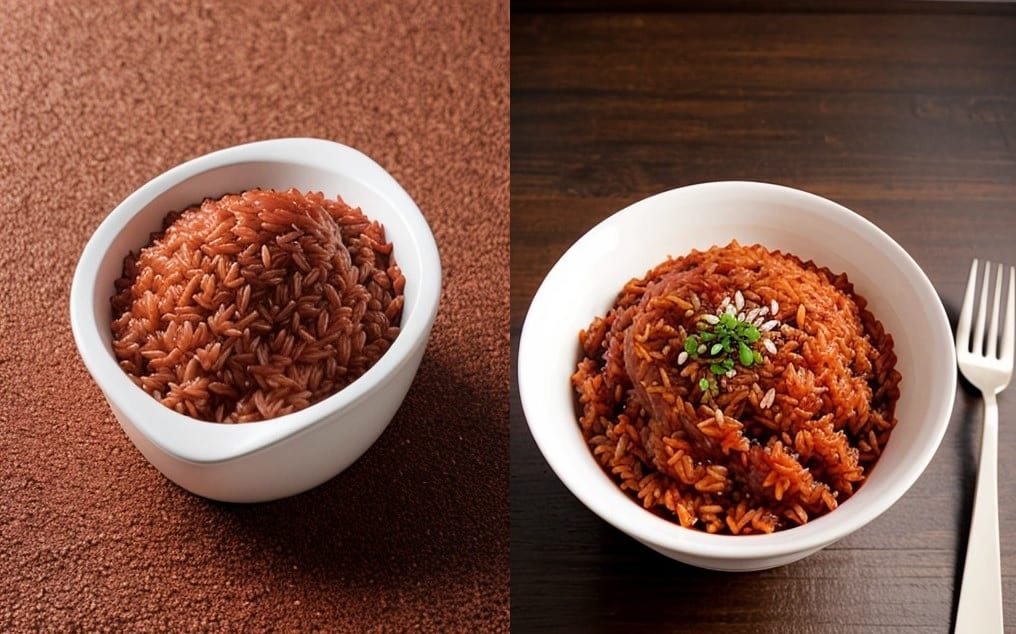
Red rice is another unrefined and unpolished rice. Just like black rice and brown rice, this colored rice also gets its outer inedible husk removed while the bran layers are left intact. Red rice also has water-soluble flavonoid or antioxidant – anthocyanin – which gives this colored rice a red hue. The anthocyanin present in red rice is different than the one present in black rice, hence there is a color difference. In black rice, the major anthocyanin is called ‘cyanidin 3 glucoside’ while major anthocyanin in red rice is called – ‘flavan 3 ols’.
The usage of red rice is abundant in various Asian countries. Since ancient times, in the Indian subcontinent, South-East Asian, and East Asia, red rice has been cultivated and consumed for its nutritional and medicinal values. In current times, in Asian countries such as China, India, Thailand, Bhutan, Malaysia, etc, red rice has been produced and consumed. Interestingly, red rice is not a single variety of rice instead it has many varieties and types depending on where is being produced.
In China, a type of fermented red rice is produced. It is known as Red Yeast Rice and it is being fermented using a mold named Monascus purpureus. In Japan, this colored red rice is termed as ‘Red Rice Koji’. Incidentally, some red yeast rice products, sold in the USA as health supplements, are being banned by US FDA. In India, various types of red rice can be found among which ‘Rakthashali’ and ‘Matta Rice’ are noteworthy. Various varieties of Indian colored red rice are used in traditional Indian medicines – ‘Ayurvedas’. Different types of red rice can be found in Bhutan, Malaysia, Thailand, and in many other Asian countries.
Some varieties of red rice can be found in Africa. A type of red rice named – ‘cira mahingou’ can be found in some African countries and has been cultivated for thousands of years. In the Camargue region of France, a variety of red rice has been cultivated for centuries which is being recognized in France and the European region for its uniqueness. Another type of red rice, called weedy rice, can be found in many places in the United States, Brazil, Cuba, Costa Rica, and some parts of Europe which have lower grain yield compared to the traditional rice varieties. It is considered a weed and could negatively affect the production of various common rice varieties.
Just like other varieties of colored rice, red rice has low calories and more dietary fiber than white rice. More fiber in this colored rice means that it takes more time to digest and makes us feel less hungry. It also has a low glycemic index compared to white rice, hence it takes more time to turn to glucose in our bloodstream. Low calorie, high fiber content, and low glycemic index in this colored rice help us regulate our blood sugar levels and fight off type-2 diabetes. It also helps us maintain our weight. Antioxidants present in red rice improve our overall immunity.
Antioxidants in red rice reduce cell damage and promote healthy cell growth. The various anthocyanin antioxidants protect our skin from UV rays and boost the health of our skin. This colored rice also helps us lower bad cholesterol in the bloodstream and improves our heart health. Red rice is rich in various essential minerals such as iron, zinc, magnesium, manganese, calcium, etc. While iron helps create red blood cells in our bloodstream, magnesium promotes better oxygen consumption. Zinc helps repair damaged cells, improve immunity, and boost our nervous system. Calcium improves our bone density. This colored rice is also a great source of various vitamins such as vitamin E, B1, B2, B6, etc.
Cautionary Words
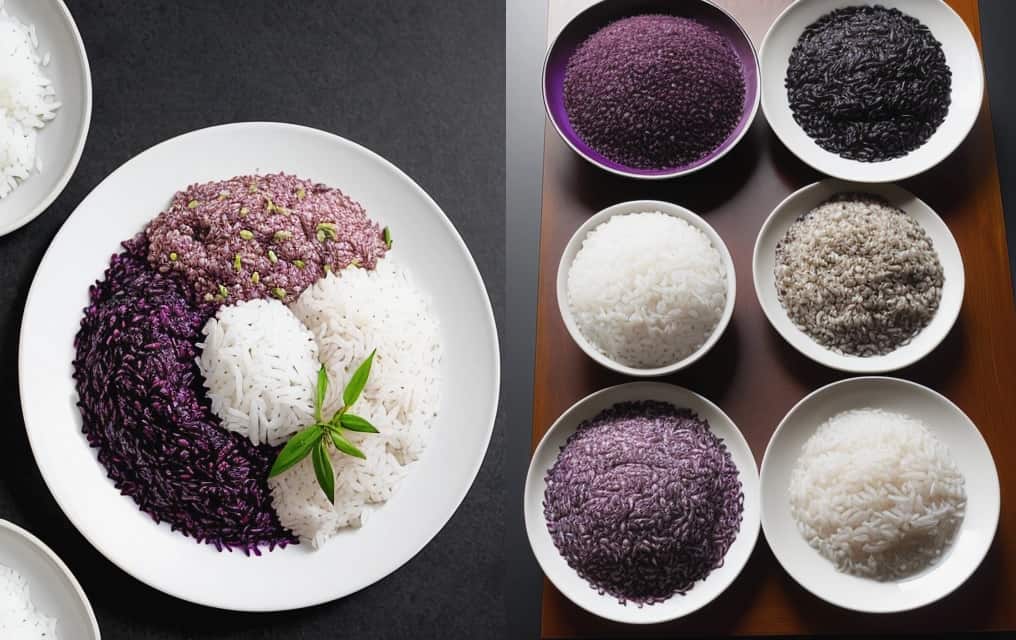
These four types of colored rice are good options for a healthy lifestyle and one can definitely replace the white rice with these options. However, some things must be remembered while including these colored rice in daily eating habits. As these colored rice have a lot of fiber, overconsumption of these colored rice may lead to indigestion and boating. These colored rice also take longer to digest hence one might feel extremely uncomfortable if he or she overeats these rice.
Also, colored rice may be a good option if compared with white rice which is basically packets of pure carbohydrates, but there are many better options available in terms of staple food. Any whole grain such as whole wheat, barley, millet, oats, rye, etc, is a much better choice compared to colored rice. These whole grain options have more antioxidants, dietary fiber, vitamins, minerals, etc compared to any type of rice – white or colored. So instead of changing white rice with any of the colored rice, one can opt for whole grains.
*This article is for information purposes only. Do not make your critical decision solely based on the information provided in this article.
**In case of a medical emergency, please consult a medical professional or a doctor.
Read More Science and Space Articles
- Top 8 Important Wellness Habits That You Must Follow
- 8 Greatest Achievements of NASA That You Should Know About
- Top 5 Amazing Whole Grains That Are Healthier Than Rice
- Indian Space Program: 8 Incredible Achievements
- China’s Space Program: 5 Amazing Accomplishments
- Top 6 Amazing Sources of Vitamin C (Fruits and Vegetables) That You Can’t Avoid
- Oranges: 11 Incredible Facts About This Tangy Citrus Fruit
- NASA’s MOXIE Creates O2: Big Step Towards Mars Colonization
- Lemons: 8 Astounding Facts About This Remarkable Super Fruit
- Top 5 Bitter Vegetables That Are Incredible For Our Health
- Grapefruit: 8 Incredible Facts About This Amazing and Tasty Superfruit
- Top 5 Amazing Properties of Time That Defy Common Sense
- Top 5 Important Citrus Fruits That You Should Know About
- 10 Factors for Emergence of Intelligent Life in The Universe
- Top 4 Important Vegetable Groups That You Should Be Aware Of
- Space Science: 6 Vital Reasons Why We Should Invest in It
- Solar System: 10 Astonishing Uniqueness of our star system
- Our Universe: An Incredible Journey of 13.7 Billion Years
- Indian Gooseberry (Amla): 10 Amazing Facts About This Wonder Fruit
- Top 6 Solar System Objects That Might Destroy Life On Earth
- The Great Physicist Peter Higgs Passes Away at 94
- Certain End of The Universe: 4 Forces of Nature to Watch Out For
- Big Bang: An Incredible Start of Universe 14 Billion Years Ago

